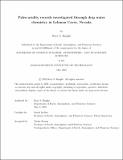| dc.contributor.advisor | McGee, David | |
| dc.contributor.author | Knight, Rory S. | |
| dc.date.accessioned | 2025-07-07T17:37:30Z | |
| dc.date.available | 2025-07-07T17:37:30Z | |
| dc.date.issued | 2025-05 | |
| dc.date.submitted | 2025-05-23T17:10:49.022Z | |
| dc.identifier.uri | https://hdl.handle.net/1721.1/159896 | |
| dc.description.abstract | In the Great Basin of the southwest United States, climate change is predicted to cause increased precipitation variability, making the future climate of the region uncertain. The paleoclimate record has direct examples of dramatic changes in water availability in this area, allowing for a comparison of precipitation changes and responses for the Great Basin. In Lehman Cave, Nevada, ten drips above actively-forming stalagmites were sampled monthly. Glass growth plates were also placed above three actively-forming stalagmites, allowing for the collection of new calcite growths. This project analyzed the samples for Mg/Ca, Sr/Ca, and U/Ca ratios to provide a comparison of the composition of calcite and the drip waters from which they precipitate. This will improve our understanding of the paleo-aridity of the Great Basin region, as well as provide useful context for the changing precipitation patterns expected with modern climate change. | |
| dc.publisher | Massachusetts Institute of Technology | |
| dc.rights | In Copyright - Educational Use Permitted | |
| dc.rights | Copyright retained by author(s) | |
| dc.rights.uri | https://rightsstatements.org/page/InC-EDU/1.0/ | |
| dc.title | Paleo-aridity records investigated through drip water chemistry in Lehman Caves, Nevada | |
| dc.type | Thesis | |
| dc.description.degree | S.B. | |
| dc.contributor.department | Massachusetts Institute of Technology. Department of Earth, Atmospheric, and Planetary Sciences | |
| mit.thesis.degree | Bachelor | |
| thesis.degree.name | Bachelor of Science in Earth, Atmospheric, and Planetary Sciences | |
